SpaceX Pulls Off Historic Launch And Return Of Rocket After Delivering Satellites Into Orbit
Last night, SpaceX successfully launched a rocket to the edge of space, deployed cargo, and returned to Earth. A huge and potentially revolutionary accomplishment.
Elon Musk’s SpaceX, the private company that has taken on the task of delivering satellites into orbit as well as serving as a launch platform for cargo vehicles to the International Space Station, had a spectacular success yesterday of its newest project, a rocket that launches vehicles into orbit and then returns to Earth:
People living along the central Atlantic coast of Florida have for decades enjoyed the spectacle of rockets headed for space. On Monday night, they were treated to a new sight that may become common: a rocket coming back down to a gentle landing.
“It really felt like it was right on top of us,” Elon Musk, the chief executive of Space Exploration Technologies Corporation of Hawthorne, Calif., or SpaceX for short, said during a telephone news conference afterward.
With the rush of sound from the rocket engines, Mr. Musk, who was at the launch site in Florida, said he initially thought the landing was a failure, ending with an explosion. But then he heard from mission control that the booster was standing, in one piece.
For SpaceX, the 8:29 p.m. liftoff of the Falcon 9 rocket from Cape Canaveral Air Force Station was a threefold success.
First, it marked the company’s return to flight after half a year. In SpaceX’s last launch attempt, a rocket taking supplies to the International Space Station disintegrated. (This time, the rocket was carrying a commercial payload: 11 small data-relay satellites for Orbcomm of Rochelle Park, N.J.)
Second, SpaceX’s upgraded design for its Falcon 9 rocket worked flawlessly. The liquid oxygen was chilled to minus 340 degrees Fahrenheit, about 40 degrees colder than on earlier flights, and the kerosene fuel was cooled to 20 degrees instead of 70 degrees.
Mr. Musk explained last week via Twitter that the lower temperatures improved performance of the rocket engines.
Most significant to SpaceX’s ambitions, however, is that after the second stage of the rocket with the satellites continued on to orbit, the engines of the booster stage reignited to turn it around, back to Cape Canaveral. Ten minutes after launching, it set down six miles to the south at Landing Zone 1, a former launch complex for Atlas intercontinental ballistic missiles that SpaceX has leased.
“The Falcon has landed,” a launch commentator said during SpaceX’s webcast as applause and cheers erupted at SpaceX’s California headquarters, followed by chants of “U.S.A.! U.S.A.!”
SpaceX had twice tried to land its Falcon 9 boosters on a floating platform in the Atlantic. Both times, the boosters reached the platform but fell short of a successful landing. The first time, the rocket ran out of hydraulic fluid, crashed and exploded. The second attempt was closer, but the booster tipped over.
If rocket stages can be refurbished and relaunched, the cost of traveling to space could be greatly reduced, Mr. Musk has said. He said SpaceX planned to refly the rocket booster. “It’ll be straightforward, actually,” he said.
The Washington Post has more:
CAPE CANAVERAL, Fla. — Elon Musk’s SpaceX successfully landed the first stage of its Falcon 9 rocket at its landing pad here Monday evening in its first flight since its rocket exploded six months ago.
The historic landing, the first time a rocket launched a payload into orbit and then returned safely to Earth, was cheered as a sign that SpaceX, the darling of the commercial space industry, has its momentum back.
“The Falcon has landed,” a SpaceX commentator said on the live webcast, as workers at its headquarters went wild, chanting “USA! USA!”
Monday’s flight, initially delayed because of technical concerns, was the second time in a month that a billionaire-backed venture launched a rocket to space and recovered it. And it represents yet another significant step forward in the quest to open up the cosmos to the masses.
In a call with reporters, Musk said that it appeared the stage landed “dead center on the landing pad. … We could not have asked for a better mission.” He called it a “revolutionary moment.”
Typically, rocket boosters are used once, burning up or crashing into the ocean after liftoff. But Musk, the billionaire co-founder of PayPal and Tesla, and Jeffrey P. Bezos, the founder of Amazon.com who has his own space company, have been working on creating reusable rockets that land vertically by using their engine thrust. If they are able to recover rockets and fly them again and again, it would dramatically lower the cost of space flight.
Reusing the first stage, which houses the engine and is the most expensive part of the rocket, was thought impossible by many just a few years ago. But last month Bezos’s Blue Origin flew a rocket to the edge of space, and landed it in a remote swath of West Texas. (Bezos owns The Washington Post.)
On Monday, SpaceX’s first flight since its Falcon 9 rocket blew up in June, Musk topped his fellow tech billionaire and space rival, by landing a larger, more powerful rocket designed to send payloads to orbit, and not just past the boundary of what’s considered space. It was a much more complicated feat that was celebrated as another leap forward for Musk and his merry band of rocketeers.
SpaceX’s unmanned — and recently upgraded — Falcon 9 rocket launched from Cape Canaveral at 8:29 p.m. on a mission to deliver 11 commercial satellites into space for Orbcomm, a communications company. A few minutes later, the second stage separated and headed further on while the towering booster performed an aerial U-turn and headed back to Earth, hurtling back through gusty winds and using its engine thrust to slow down.
Guided by fins on the side of the rocket, it steered toward the landing pad SpaceX has built on the Cape—Landing Zone 1 — and touched down vertically in a dramatic, pinpoint landing.
Previously, SpaceX had attempted to land the first stage on a floating platform Musk calls an “autonomous spaceport drone ship.” Twice the rockets hit the barge, but they came down too hard or at a slight angle, and exploded.
Monday’s landing is yet another breakthrough for SpaceX, which was the first commercial company hired by NASA to ferry supplies to the International Space Station. And it won another contract, along with Boeing, to fly astronauts to the station, as soon as 2017.
But as SpaceX, based outside of Los Angeles, has evolved from spunky start-up to a mainstream space company, it remains focused on its main mission: one day flying to Mars, which Musk hopes humans will eventually colonize. While it has raised revenue by flying for NASA and commercial satellite companies, SpaceX has continued to push toward developing the technologies that eventually would make humans a “multi-planet species,” as Musk says.
To do that, the cost of space flight, now prohibitively high, would have to come down significantly. And the ability to reuse rockets ultimately will make space travel more accessible, he has said.
As Musk said during a forum last year, there are “no runways on Mars,” meaning rockets would have to land using the thrust in their engines.
“You really have to get good at propulsive landing if you want to go somewhere other than earth,” he said.
The idea of a vehicle going into space and returning to Earth and reusable rockets isn’t entirely new, of course. This is what the Space Shuttle Program spent some twenty years doing with a Space Shuttle that was designed to return to Earth as a plane after having been launched into space, at least in part, by a pair to twin rocket boosters that would fall away during launch so that they could be retrieved, refurbished, and reused for future launches. The differences between the Shuttle program and what SpaceX achieved last night, though, are significant and likely to be revolutionary when it comes to the launch of satellites and cargo vessels for the International Space Station, and potentially also for manned flights meant for Earth orbit or journeys to the ISS. Essentially, what SpaceX has designed is a two-stage rocket system where the first stage takes the second stage to the edge of space, deploys the second stage which eventually launches its cargo, and then the first stage returns to Earth where it can be refurbished and reused in the future. The fact that it’s landing vertically on what essentially amounts to a landing pad, rather than falling into the ocean where they must be located and retrieved makes the entire process far simpler and less expensive. There are also some rather obvious implications in the military arena for the use of this kind of launch capability that I’m sure the Defense Department will be quite interested in going forward.
Vox’s Libby Nelson explains further why this achievement, which of course will still need to be tested further before it becomes commonplace, could be revolutionary:
Creating a reusable rocket has been a major goal for SpaceX, and one it’s struggled with. Earlier attempts this year failed, and in June, an uncrewed SpaceX rocket exploded in midair. This was the first flight since June’s failure.
Jeff Bezos’ private spaceflight company Blue Origins successfully landed a rocket in June, although it only went into suborbital space, not all the way into orbit. (“Welcome to the club,” Bezos tweeted at Musk.)
SpaceX made a few changes to the rocket, including trying to land it on the ground rather than on a platform on the ocean, one of the things that made the earlier attempts so challenging.
Landing the rocket is revolutionary not just because it was a feat of impressive engineering, but because it could eventually make space travel cheaper. Most of the equipment used to put cargo or people in orbit is destroyed after each use. SpaceX Musk famously likened this to throwing away a brand-new 747 after a single flight to London.
From the beginning, his company has sought to make spaceflight possible with reusable components. Building a new Falcon 9 rocket costs $54 million, but using it to put a payload into orbit costs only about $200,000 worth of fuel. Figuring out a way to reuse the rocket could make all sorts of missions — commercial satellite launches, collaborations with NASA, and space tourism — cheaper by orders of magnitude.
Via The New York Times, here is an edited video that shows the launch and landing in a single, edited, video:
If you’d like you can also watch the full 45 minute Space X webcast of last night’s event:
To a large degree, making launches, both of cargo and eventually people, less expensive and more efficient has been the focus of what SpaceX, Bezos’s company, and other ventures have been doing for several years now, and it has taken on a new tone since the end of the Space Shuttle program several years ago. Three years ago, not long after the end of the Space Shuttle program, SpaceX successfully completed the launch of its Dragon cargo vehicle to the International Space Station, thus giving NASA a way to resupply the platform that wasn’t dependent on the use of Soyuz spacecraft launched from Russia’s space facility in Kazakhstan. At the end of that mission, when the Dragon was successfully returned to Earth and retrieved, I noted that we had entered a new era in both space exploration, travel, and the launch of vehicles into orbit thanks in no small part to the beginning of what was largely an entirely private venture that, although it worked in conjunction with NASA due to the nature of the mission, was not necessarily dependent on government funding going forward since there would eventually be nothing stopping a company like SpaceX from entering into direct contracts with private industries to put cargo into orbit. There have been setbacks since then, of course, including the spectacular loss of an Orbital Sciences rocket intended to send cargo to the ISS just last year, but as I said at the time, there had also been failures along the way in NASA’s initial days, that launching vehicles into orbit would remain a risky venture for some time to come, but that the process was clearly moving forward in a way that was allowing for the development of innovative ways to launch vehicles thanks in no small part to the involvement of private industry in the process. Last night’s launch is a great example of what I meant since it was the desire to find a way to control the cost of launches that led SpaceX to begin explore the idea of a reusable vertical take off and landing rocket to begin with. Now, they’ve proven that it can be done, and that’s a great accomplishment.
Photo of single-exposure of launch and landing via SpaceX
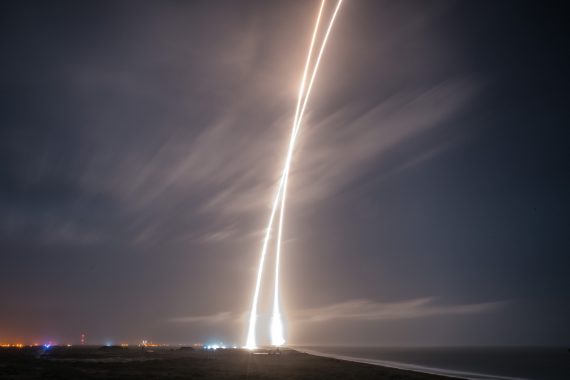

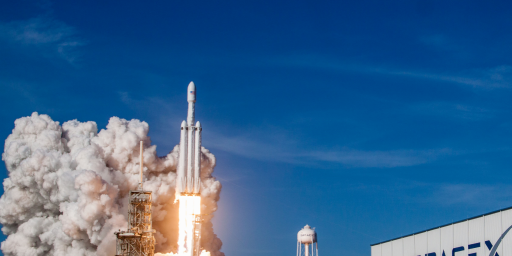
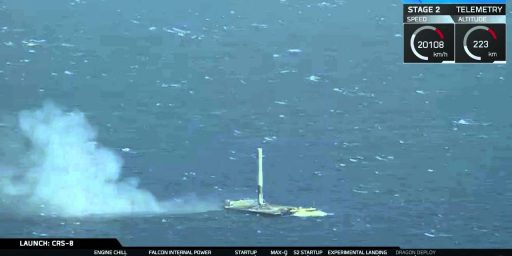
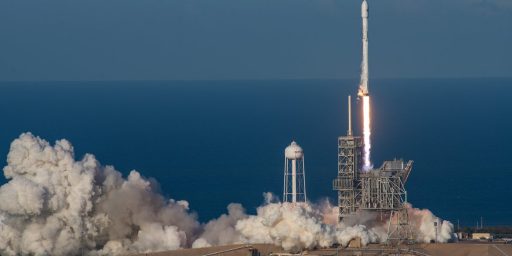
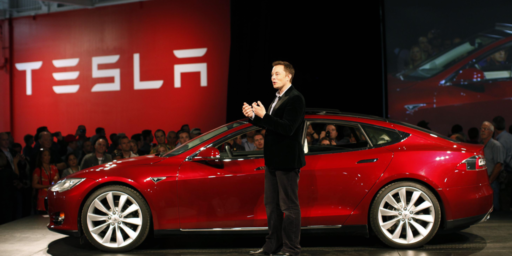
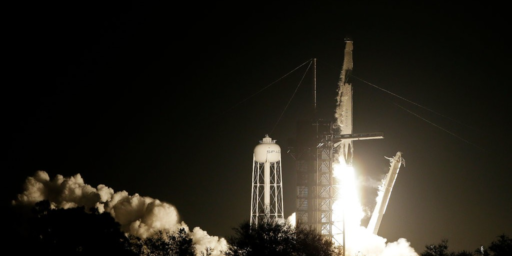
Now that’s just plain cool.
Certainly a great accomplishment for Musk and his team of engineers. I still think his idea of colonizing Mars is a fools errand however.
Indeed.
As long as we realize that the likelihood of failure is still large and don’t get discouraged. Which is true for any new technology.
Ron–the major problem with colonizing Mars (unless you do it completely in an enclosed environment) is the bloody friggin’ solar wind stripping away the atmosphere of Mars because Mars doesn’t have a magnetic field.
I know we’ve got gung-ho planetary engineering types, but creating a magnetic field for Mars is a wee bit over the top….
Wow–actually, if you check on the web, there’s quite a lot of discussion about how to give Mars a magnetic field. Most of them involve slamming asteroids into it.
@grumpy realist: Yeah! Deliberately slamming asteroids into a neighboring planet–what could go wrong?
@grumpy realist: Considering the mucked up job we’ve done engineering our present planet I don’t expect they’ll do better with Mars.
I’m glad Musk was successful. It’s important to realize that we are still a long, long way away from colonizing Mars. Essentially we are where Eutope was around 1000AD as regards transatlantic travel. We have some idea of how to cross the Atlantic but we haven’t built the ships yet that can do it. Even more important, we have no good reason to go there. , other than curiosity. There are as yet zero economic reasons to colonize Mars, which means it won’t be done.
Now asteroid mining has possibilities… But even that’s a long shot.
Still kudos to Musk. He is moving us one step forward in a long journey.
@grumpy realist: It’s not just stripping away the atmosphere but the constant bombardment of solar and cosmic radiation. You would have to live well below the surface of the planet.